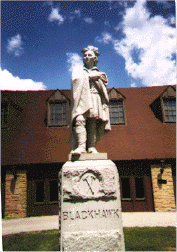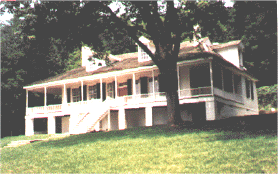American Expansion: 1780 - 1855
- American Settlements
- Progress in the new State
- The Emergence of Abraham Lincoln

American Settlements
| Most of the early
American settlements in Illinois were in the southern part of the state along
the Mississippi and Ohio River valleys. The French influence was still felt in the
northern part of the territory. Jean Baptiste Du
Sable, a black Haitian trader, established a trading post at the mouth of the
Chicago River in 1779. In 1784, Virginia gave up its claim on Illinois to the United
States government. The Northwest Territory, which included Illinois, was established on
July 13, 1787. General Arthur St. Clair was appointed governor of the Northwest Territory.
He created the first county in Illinois in 1790 and named it St. Clair County.
Cahokia
served as the seat of the new county's government. Illinois became part of the Indiana
Territory in 1800. The Americans built
Fort Dearborn
near Lake Michigan in 1803, at the site of present day Chicago.
In 1809, the Illinois Territory
was created, consisting of present day Illinois and Wisconsin. Kaskaskia became the first
territorial capital. The first territorial governor was
Ninian Edwards. |
Conflicts arose between Indians living in Illinois and the newly formed United States
during this period. The Sauk and Mesquakie Indians fought against the Americans during the
Revolutionary War. The Americans destroyed the Indian village of Saukenuk,
near present day Rock
Island, in 1780.
In 1804, several chiefs of the Sauk and Mesquakie tribes
signed a treaty giving their land in Illinois to the United States. Many of the Sauks
refused to recognize this treaty as legal. Led by the warrior
Black Hawk, they sided with
the British in the
War of
1812. They defeated the Americans in battles at Campbell's
Island and Credit Island along the Mississippi River.
|

This statue of the Indian warrior Black Hawk is at the Black Hawk Historic Site in Rock
Island. |
|
White settlers were also overrunning the Potawatomi Indian
land during this period. Consequently, the Potawatomi attacked Fort Dearborn in August
1812 and killed a number of women, children and soldiers. In October 1812, the Potawatomi
Indian villages around Peoria were destroyed by United States troops led by Ninian
Edwards. The next year, the French citizens of Peoria were deported to an area near Alton.
Fort Clark was built at Peoria in 1813 to protect the incoming settlers. The Potawatomis
attacked and destroyed Fort Clark in 1819. Skirmishes between the Potawatomi
Indians and the United States continued for the next few years.
|
As the white population in Illinois increased, the settlers began a campaign for
statehood. The
first
constitution of Illinois was adopted at Kaskaskia on August 26, 1818.
Illinois became the 21st state on December 3, 1818.
Shadrach Bond
was elected the first Governor and
Pierre Menard
the first Lieutenant Governor. Kaskaskia was the first state capital. The capital was
moved to Vandalia
in 1820. After statehood, the white population of Illinois grew rapidly. There were more
than 150,000 white residents by 1830. |
 The
home of Pierre Menard near Kaskaskia was known as the "Mount Vernon of the
West". |
Because of the increase in the white population, Indians living in Illinois were forced
to abandon the land they had lived on for centuries. The Sauk and Mesquakie Indians in
northern Illinois moved west of the Mississippi River into Iowa. In 1832,
Black Hawk
and his followers returned to Illinois to reclaim their land. After several fierce
battles, Black Hawk was chased into southern Wisconsin and defeated at the
Battle of Bad
Axe on August 2, 1832. Black Hawk and his sons were eventually captured. The end of this
war was the last Indian uprising in Illinois.
As the United States presence expanded in North America, treaties
were signed with many of the Indian tribes who lived on the land. These treaties professed
to protect Indian land while allowing white settlement. However, violations of these
treaties occurred frequently. Eventually, the United States decided to relocate all of the
Indian tribes living east of the Mississippi River. The
Indian Removal Act of 1830 forced
these tribes to move to Indian territory in Kansas or Oklahoma. The Peoria, Kaskaskia,
Sauk, Fox, Chippewa and Potawatomi were sent to Kansas.
The move caused great hardship for the
emigrant tribes. Many Indians died on the trip. Once they arrived, they found
land that was very different from their original lands and had a difficult time surviving.
The Cherokee Indians of the southeastern United States traveled through southern Illinois
to Oklahoma on what became known as the
"Trail of Tears"
because of the number of deaths which occurred along the way.

Additional Resources

Study Guide Questions
- Why were the first American settlements mainly in the southern
part of Illinois?
- Who established a trading post at the site of
present day Chicago in the early 1800's?
- What was the first county in Illinois and what city
was the county seat?
- Who was Ninian Edwards?
- When did Illinois become a state and who was the
first Governor?
- Who was Black Hawk and how did he and his followers
react to Illinois becoming part of the United States?
- What effect did United States westward expansion have on the
Indians living in Illinois?
Back to Top |